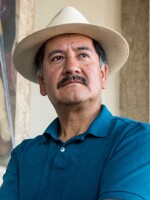As the sun sets on the Pacific Coast town of Ometepec, Mexico, musicians and fans gather on a rooftop to enjoy boleros. The crowd of about 70 people listens attentively to Las Hermanas García perform "Que Sepan Todos." Most of the audience is made up of teenagers and the García sisters take note. (Celia García is 16 years old herself. Laura García is 17.)
Bolero, the romantic Latin music style, was born in Cuba and migrated around the world. It took root in Mexico and became extremely popular in the 1950s. Now, with acts like Las Hermanas García, it's enjoying a revival. Laura notes part of the excitement to perform is because they are "helping to spread the bolero." Celia says boleros are part of their DNA.
"It's a genre that we heard since we were in my mother's womb," Celia says. "This region has always been known to be very romantic. My father used to sing serenades to my mother and now we listen to this music."
Mariano García, Celia and Laura's father, is also their arranger and lead guitarist. He says his daughters started singing together before they were 10.
"I coached them a little bit with their voices, but really they're natural singers," Mariano explains. "Early on, I saw them singing in two-part harmonies. I don't know how they did it. Celia took the first voice and Laura second and suddenly they were making music."
The bolero planted roots in Mexico's Pacific Coast, known as the Costa Chica, in the mid-1950s, when a prolific composer from the region named Álvaro Carrillo began to score hits in Mexico City and beyond. His most famous tune, "Sabor a Mí," has been recorded by dozens of singers worldwide, including Doris Day, Frank Sinatra and Eydie Gormé.
The legacy of Carrillo and other composers of his generation is still felt today across the country. Mexico City has a boleros-only radio station and national pop stars have made boleros a regular part of their repertoires. Ramón Estrada, the host of a radio program in Ometepec, says boleros are so popular in the Costa Chica, that you can go to any party and hear a bolero group.
"For more than fifty years, those boleros from that period have been transmitted from one generation to the next. And with this new revival, this tradition will continue for a long time," Estrada says.
The boleros have become such a big part of people's lives, they take them wherever they go. "They're listening to Radio Ometepec [and] to the García sisters in the U.S.," Estrada says. "They call us from New York, Los Angeles, Texas and Miami. There are a lot of people there who are from all these towns along the Coast. Just imagine how they feel being so far away from the Costa Chica and listening to songs from here."
The Garcia sisters are in the process of rehearsing songs they plan to record for their second album. This time, they want to sing boleros from other coasts of Latin America. And their music is spreading even further. Celia and Laura recently performed at La Clave Festival in London in front of thousands of people.
"We're doing what we like to do," Celia says. "And I think that when you're doing what you really like to do, you don't feel pressure, you just do it."
Copyright 2022 NPR. To see more, visit https://www.npr.org.





